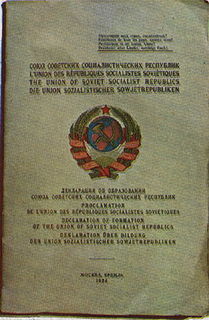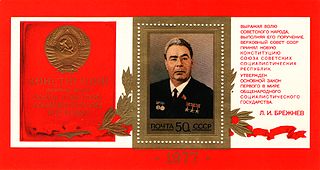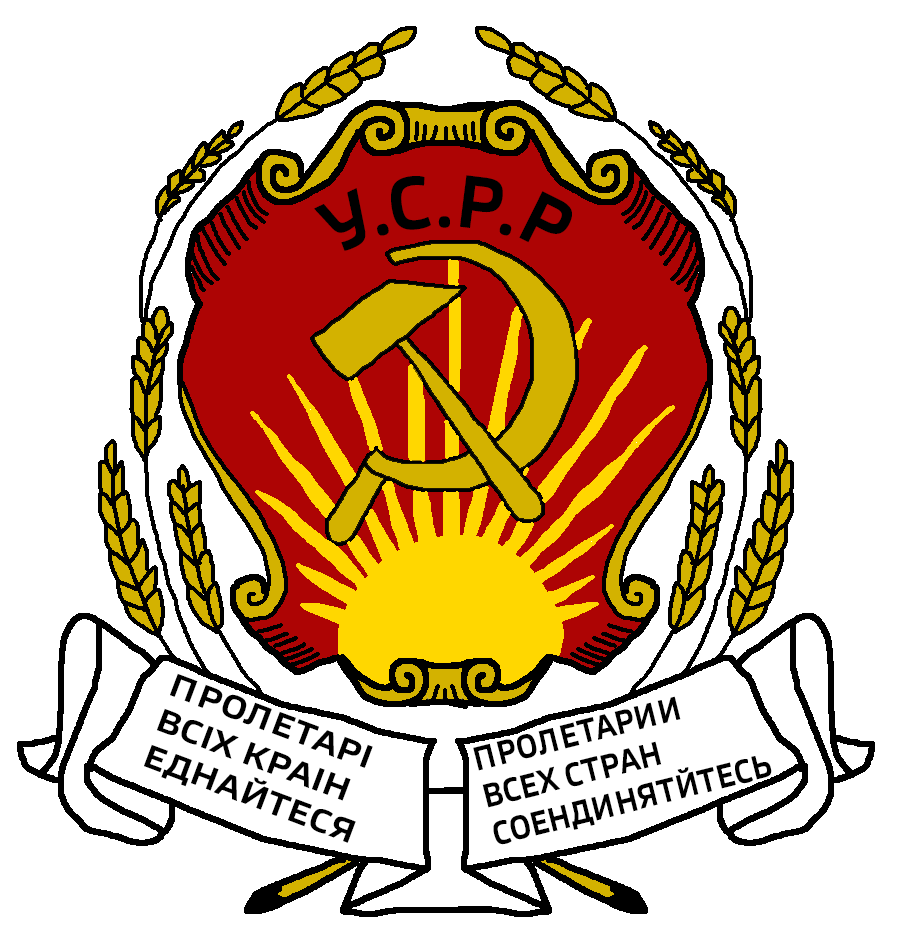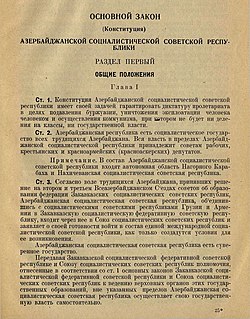The 1924 Soviet Constitution legitimized the December 1922 Treaty on the Creation of the USSR between the Russian Soviet Federative Socialist Republic, the Ukrainian SSR, the Byelorussian SSR, and the Transcaucasian SFSR to form the Union of Soviet Socialist Republics.

There were three versions of the constitution of the Union of Soviet Socialist Republics, modeled after the 1918 Constitution established by the Russian Soviet Federative Socialist Republic (RSFSR), the immediate predecessor of the Soviet Union.

The Treaty on the Creation of the USSR officially created the Union of Soviet Socialist Republics (USSR), commonly known as the Soviet Union. It de jure legalised a union of several Soviet republics that had existed since 1919 and created a new centralised federal government where key functions were centralised in Moscow.

The Russian Soviet Federative Socialist Republic, previously known as the Russian Soviet Republic and the Russian Socialist Federative Soviet Republic, as well as being unofficially known as the Russian Federation, Soviet Russia, or simply Russia, was an independent state from 1917 to 1922, and afterwards the largest, most populous and most economically developed of the 15 Soviet socialist republics of the Soviet Union (USSR) from 1922 to 1991, then a sovereign part of the Soviet Union with priority of Russian laws over Union-level legislation in 1990 and 1991, during the last two years of the existence of the USSR. The Russian Republic comprised sixteen smaller constituent units of autonomous republics, five autonomous oblasts, ten autonomous okrugs, six krais and forty oblasts. Russians formed the largest ethnic group. The capital of the Russian SFSR was Moscow and the other major urban centers included Leningrad, Novosibirsk, Yekaterinburg, Nizhny Novgorod and Samara.
In essence, it was but an expansion and generalization of the Treaty, with most of the major parts were specified already by the treaty; it also allowed for a potential expansion of the USSR.
Whereas the original Treaty had only 26 articles, the Constitution now had 72, divided into eleven chapters. Ratified by the Second Congress of Soviets of the Soviet Union 31 January 1924, it survived six editions, before being superseded by the 1936 constitution.

The Congress of Soviets of the Soviet Union, was the supreme governing body in the Soviet Union since the formation of the USSR and until adoption of the 1936 Soviet Constitution. It is not the same as the All-Russian Congress of Soviets which governed the Russian Soviet Federative Socialist Republic
It established the Congress of Soviets to be the supreme body of state authority, with the Central Executive Committee having this authority during the interims. The Central Executive Committee is divided into the Soviet of the Union, representing the constituent republics, and the Soviet of Nationalities, representing directly the interests of nationality groups. The Central Executive Committee of the Soviet Union served as the collective presidency. Between sessions of the Central Executive Committee, the Presidium supervised the government administration. The Central Executive Committee also elected the Council of People's Commissars, which served as the executive part of the government.

The Supreme Soviet of the Soviet Union was the most authoritative legislative body of the Union of Soviet Socialist Republics (USSR) beginning 1936, and the only one with the power to approve constitutional amendments. It elected the Presidium, served as the collective head of state of the USSR, and appointed the Council of Ministers, the Supreme Court, and the Procurator General of the USSR.

The Soviet of the Union was the lower chamber of the Supreme Soviet of the Union of Soviet Socialist Republics, elected on the basis of universal, equal and direct suffrage by secret ballot in accordance with the principles of Soviet democracy, and with the rule that there be one deputy for every 300,000 people. Until Glasnost and the 1989 elections however, only candidates approved by the Communist Party of the Soviet Union were permitted to participate in the elections. As opposed to the upper chamber, the Soviet of Nationalities, the Soviet of the Union represented the interests of all of the people of the Soviet Union no matter what their nationality was.

The Soviet of Nationalities was the upper chamber of the Supreme Soviet of the Union of Soviet Socialist Republics, elected on the basis of universal, equal and direct suffrage by secret ballot in accordance with the principles of Soviet democracy. Until Glasnost and the 1989 elections, however, only candidates approved by the Communist Party of the Soviet Union were permitted to participate in the elections. It was briefly succeeded by the Soviet of the Republics from October to December of 1991.











